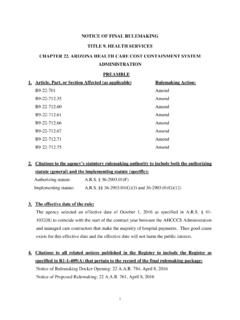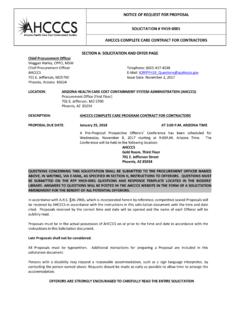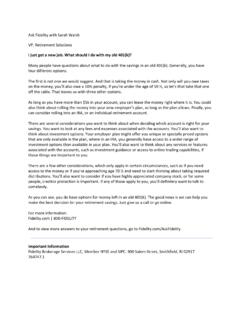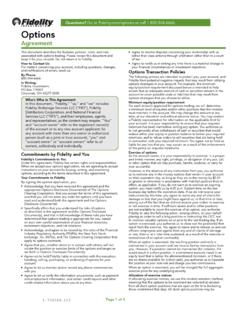Transcription of ASSERTIVE COMMUNITY TREATMENT (ACT) …
1 1 ASSERTIVE COMMUNITY TREATMENT (ACT) fidelity REPORT Date: November 9, 2015 To: Pete Tomasello, Clinical Coordinator From: Jeni Serrano, BS Eggsware, BSW, MA, LAC ADHS fidelity Reviewers Method On October 20-21, 2015, Jeni Serrano and TJ Eggsware completed a review of the Southwest Network Hampton ASSERTIVE COMMUNITY TREATMENT (ACT) team. This review is intended to provide specific feedback in the development of your agency s ACT services, in an effort to improve the overall quality of behavioral health services in Maricopa County. The Hampton clinic is located at 1440 S. Country Club Dr. in Mesa, Arizona. This ACT team currently serves 93 members and has recently gone through staff changes since last year s review. The team s prior Employment Specialist was promoted to the position of Clinical Coordinator (CC) in January, 2015.
2 The Hampton ACT team includes staff who have been with the team for many years, including their Psychiatrist (since 2004), Nurse (since 2004), Rehabilitation Specialist (formerly the team Substance Abuse Specialist, on the team since 2009), and Independent Living Specialist (on the team since 2000). The team currently has three vacancies and had two staff who were on extended leave-of-absence during this review period. The individuals served through the agency are referred to as members so that term will be used in this report. During the site visit, reviewers participated in the following activities: Observation of a daily ACT team meeting on October 21, 2015 Individual interview with Clinical Coordinator ( , Team Leader) Individual interviews with Housing Specialist (HS), Nurse, and Employment Specialist (ES) Individual interviews with two members who receive ACT services Group interview with three members who receive ACT services.
3 Charts were reviewed for ten members using the agency s electronic medical records system Review of agency Closure for Lack of Engagement Desktop Procedure, Act exit criteria screening tool and Admissions Forms. 2 The review was conducted using the Substance Abuse and Mental Health Services Administration (SAMHSA) ACT fidelity Scale. This scale assesses how close in implementation a team is to the ASSERTIVE COMMUNITY TREATMENT (ACT) model using specific observational criteria. It is a 28-item scale that assesses the degree of fidelity to the ACT model along 3 dimensions: Human Resources, Organizational Boundaries and the Nature of Services. The ACT fidelity Scale has 28 program-specific items. Each item is rated on a 5-point scale, ranging from 1 (meaning not implemented) to 5 (meaning fully implemented). The ACT fidelity Scale was completed following the visit.
4 A copy of the completed scale with comments is attached as part of this report. Summary & Key Recommendations The agency demonstrated strengths in the following program areas: The ACT team benefits from having two Nurses on staff. The ACT Nurse position is considered a critical ingredient in successful ACT teams. Having two Nurses expands the team s capacity for delivering vital services such as medication administration, health and wellness education, Primary Care Physician (PCP) coordination, and involvement in TREATMENT planning. The ACT team takes full responsibility for crisis services. The approach used by the team focuses on providing after-hours care with the same intensity as during normal business hours. The team does not immediately amend or discharge members from services due to failure to keep appointments, or for lack of engagement.
5 The staff is persistent and use street outreach as well as having the Nurses come to them to administer medications in an attempt to engage and educate members in TREATMENT . The following are some areas that will benefit from focused quality improvement: The agency needs to ensure that there is proper psychiatrist coverage; the team Psychiatrist was on extended leave of absence and has recently returned part time. The agency needs to continue to monitor and evaluate activities of the CC in order to increase COMMUNITY direct services to at least 50% of the time providing direct services. The agency needs to fill the open ACT staff positions as soon as possible; it appears many of the reduced scores identified in this review over the prior year s review are due, in part, to the shortage of staff. This will help to decrease caseload size, to support a team approach, and to increase the intensity, frequency, and diversity of services provided through the team.
6 Both Substance Abuse Specialist (SAS) positions should be filled with experienced staff so the team will be better positioned to provide individual SA TREATMENT based in an integrated TREATMENT model. The team currently does not have any SASs, therefore does not currently provide regular, direct, substance abuse TREATMENT to members with co-occurring disorders. The team needs to increase their efforts to involve members identified support system. It is recommended that the team support and encourage members to identify their informal supports ( , people not paid to support members, such as family, landlord, neighbor, friend) and then assist them in acquiring the knowledge, resources and skills needed to support members. The team should increase the intensity and duration of services to members, including COMMUNITY -based activities.
7 Services should be delivered primarily in the COMMUNITY and not the office setting; the team should identify what services are currently delivered in the clinic setting that can be provided to members in the COMMUNITY . 3 ACT fidelity SCALE Item # Item Rating Rating Rationale Recommendations H1 Small Caseload 1 5 (4) The team serves 93 members with eight staff who provide direct services (excluding the Psychiatrist and the Transportation Specialist (TS) on extended leave for over three months), resulting in a staff ratio. Recruit qualified staff to fill vacant positions, including both SAS and the Peer Support Specialist (PSS) positions. H2 Team Approach 1 5 (5) ACT members receive direct, face-to-face contact with multiple staff 90% of the time, based on records reviewed. Members interviewed reported that they are assigned a primary case manager; however, they do have contact with multiple staff, but usually for medication observations or in the clinic.
8 Staff interviewed report that they are assigned a primary caseload and also rotate contact with other members in order to meet fidelity . Brainstorm opportunities to expand the types of services delivered through the team, based on member goals and needs, when there is contact with members. As new staff are hired and further trained to fulfill specialty positions, a more diverse service mix may be delivered through the team. H3 Program Meeting 1 5 (5) The ACT team meets four days a week for their morning meeting. On Monday, Tuesday, Wednesday, and Thursday the ACT team meets from 10:30 am-12:00 pm. Monday-Wednesday all members are briefly discussed. On Thursday, the morning meeting ends later due to staff engaging in more in-depth discussion of member status and needs. The CC reported that the Psychiatrist and the two Nurses attend three out of the four days due to their flex schedules.
9 The morning meeting observed was from 10:15-11:55 (1 hour, 40 minutes). During this meeting, the CC led the meeting, and provided most updates. The majority of the meeting was focused on medication observations and medication doses; there was limited discussion regarding member needs and potential interventions. Though staff provided some When the full team is present for the meeting, and as vacancies are filled, ensure members receive support through the entire team and not primarily through one Case Manager (CM). Optimally, multiple staff would be aware of member status, with recent contacts or support discussed in order to update the full team. Some teams elect to review members by area of specialty which emphasizes the specialty positions and the integral roles they play. 4 Item # Item Rating Rating Rationale Recommendations updates, it appeared they primarily reported on their assigned member caseload or those with whom there was recent contact for medication services, and other issues were addressed as ancillary events.
10 H4 Practicing ACT Leader 1 5 (3) Based on a review of agency documentation, the ACT Clinical Coordinator (CC) provides direct care to members an average of hours a week, totaling of his time for direct contact with members. These contacts included medication observations, home visits, hospital visits, and other COMMUNITY -based services. Although not factored in this area, the CC also documented contact with member informal support systems. The CC reported that he is able to do more direct service due to his Clinical Director (CD) taking over some of the administrative duties. The provider is also monitoring direct service time as part of a broader approach to monitoring fidelity measures using the agency electronic health record. Although the CC routinely provides services, it appears the actual direct face-to-face member services account for less than 25% of his time.














